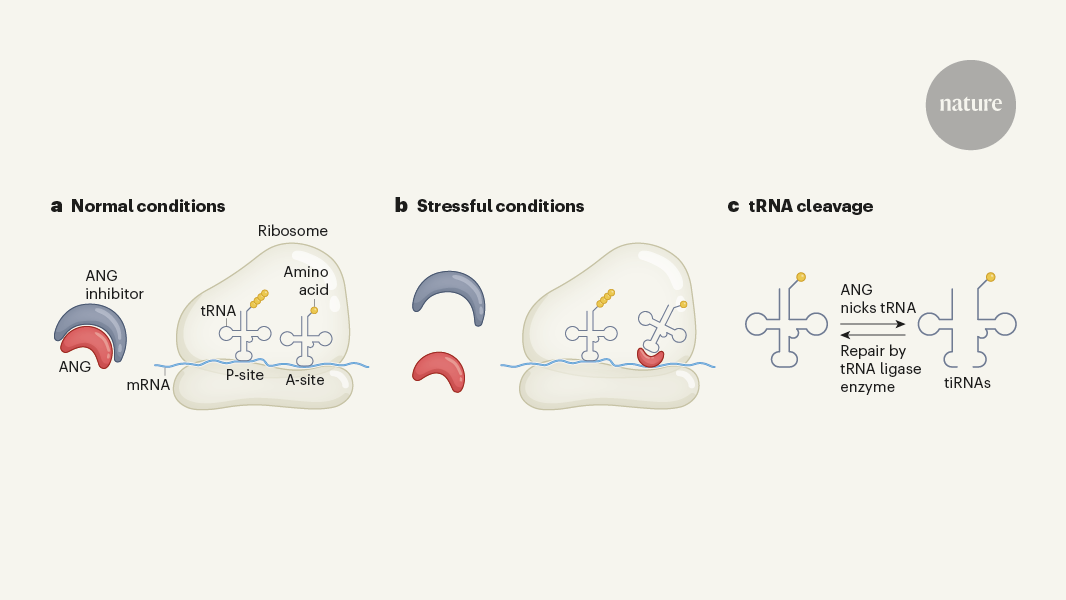Ribosomes Unexpectedly Interact with Angiogenin Enzyme to Stimulate its RNA Cleavage Activity
Core Concepts
Ribosomes, the cellular structures fundamental to protein synthesis, unexpectedly interact with the enzyme angiogenin to stimulate its RNA cleavage activity, shedding light on how angiogenin specifically targets transfer RNAs to halt translation.
Abstract
The content describes a surprising discovery about the role of ribosomes, the cellular structures responsible for protein synthesis, in regulating the activity of the enzyme angiogenin. Angiogenin is a ribonuclease that can cleave RNA, including transfer RNAs (tRNAs), thereby halting the translation process.
The key highlights are:
Ribosomes, along with transfer RNA, are fundamental to the process of translation, where messenger RNA guides the production of encoded proteins.
The authors found that ribosomes interact with the enzyme angiogenin (ANG) and stimulate its enzymatic activity.
Angiogenin is a ribonuclease that can cleave RNA, including tRNAs, thereby halting translation.
The discovery of the association between the ribosome and angiogenin sheds light on how the enzyme specifically targets tRNAs for cleavage, providing a mechanism for regulating translation.
Ribosomes unexpectedly moonlight as activators of angiogenin enzyme
Stats
Ribosomes, along with transfer RNA, are fundamental in enabling the flow of genetic information during the process of translation.
Angiogenin (ANG) is a type of enzyme called a ribonuclease that can cleave RNA, and specifically tRNAs, thereby halting translation.
Quotes
"The messenger RNA in cells guides the production of encoded proteins, a process known as translation."
"Cellular structures called ribosomes, along with transfer RNA, are fundamental in enabling the flow of genetic information during this process."
"Writing in Nature, Loveland et al.1 reveal a surprising twist — the ribosome interacts with the enzyme angiogenin (ANG) to stimulate ANG's enzymatic activity."
"ANG is a type of enzyme called a ribonuclease that can cleave RNA, and specifically tRNAs, thereby halting translation2."
Key Insights Distilled From
by Pavel Ivanov at www.nature.com 06-12-2024
https://www.nature.com/articles/d41586-024-01510-w
Deeper Inquiries
What are the potential physiological or pathological implications of the ribosome-angiogenin interaction and its regulation of translation?
The interaction between ribosomes and angiogenin (ANG) and its role in regulating translation can have significant implications in both physiological and pathological conditions. Physiologically, this interaction may play a crucial role in fine-tuning the translation process by modulating the activity of ANG. ANG's ability to cleave tRNAs can impact protein synthesis, and the ribosome's activation of ANG could serve as a regulatory mechanism to control translation rates in response to cellular needs. This regulatory function could be essential for maintaining cellular homeostasis and responding to environmental cues.
Pathologically, dysregulation of the ribosome-ANG interaction could lead to aberrant translation and protein synthesis, which are implicated in various diseases, including cancer and neurodegenerative disorders. If the interaction is disrupted, ANG may inappropriately cleave tRNAs, leading to translation errors or stalling, which can result in the production of faulty proteins or the dysregulation of essential cellular processes. This disruption could contribute to disease progression by altering the proteome composition and affecting cell viability and function.
How might the disruption of the ribosome-angiogenin interaction affect cellular processes, and could this be a target for therapeutic interventions?
Disruption of the ribosome-ANG interaction could have profound effects on cellular processes, particularly those related to protein synthesis and translation. If the interaction is disrupted, ANG may dysregulate tRNA cleavage, leading to translational errors, protein misfolding, and the accumulation of aberrant proteins. This can disrupt normal cellular functions, compromise cell viability, and contribute to the development of diseases.
Targeting the ribosome-ANG interaction could hold therapeutic potential for conditions where dysregulated translation plays a role, such as cancer or neurodegenerative disorders. By modulating this interaction, either through small molecules or other interventions, it may be possible to restore normal translation rates, correct protein synthesis errors, and mitigate the pathological consequences of disrupted ribosome-ANG activity. Developing therapeutics that specifically target this interaction could offer a novel approach to treating diseases associated with translation dysregulation.
Given the fundamental role of ribosomes in protein synthesis, how might this unexpected moonlighting function of ribosomes in regulating angiogenin activity inform our understanding of the complex interplay between different cellular machineries?
The discovery of ribosomes' unexpected role in activating angiogenin (ANG) and regulating its enzymatic activity provides valuable insights into the intricate interplay between different cellular machineries. Ribosomes, traditionally known for their central role in protein synthesis, now demonstrate a moonlighting function in modulating ANG activity, a ribonuclease involved in tRNA cleavage. This finding highlights the versatility and multifunctionality of cellular components, showing that ribosomes can participate in diverse cellular processes beyond translation.
Understanding this novel function of ribosomes sheds light on the complex regulatory networks within cells and how different cellular machineries collaborate to maintain cellular homeostasis. The interaction between ribosomes and ANG reveals a sophisticated mechanism by which protein synthesis can be finely tuned and regulated in response to internal and external stimuli. This newfound knowledge deepens our appreciation of the dynamic and interconnected nature of cellular processes, emphasizing the need to consider the multifaceted roles of cellular components in orchestrating biological functions.
0
